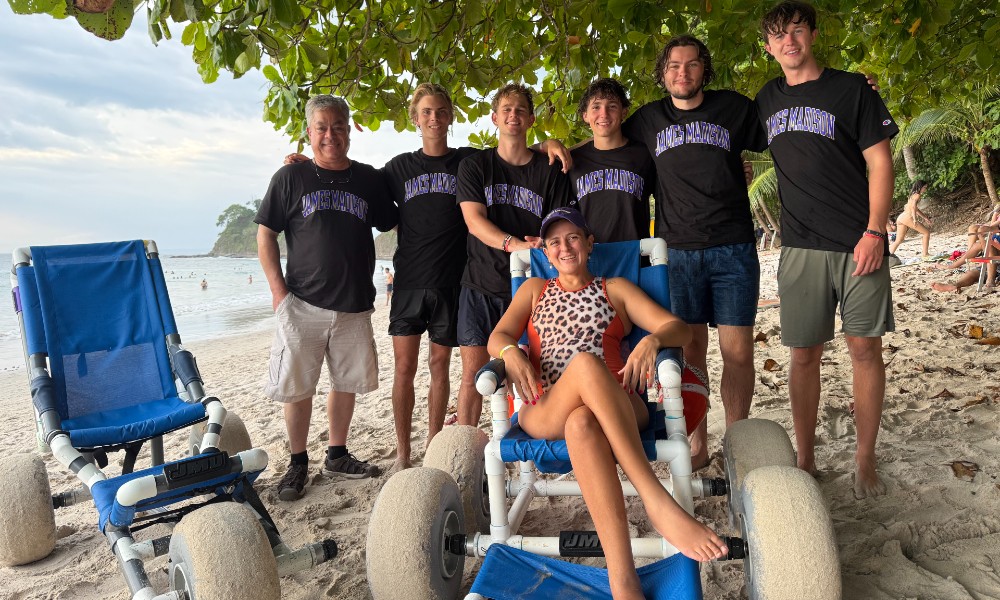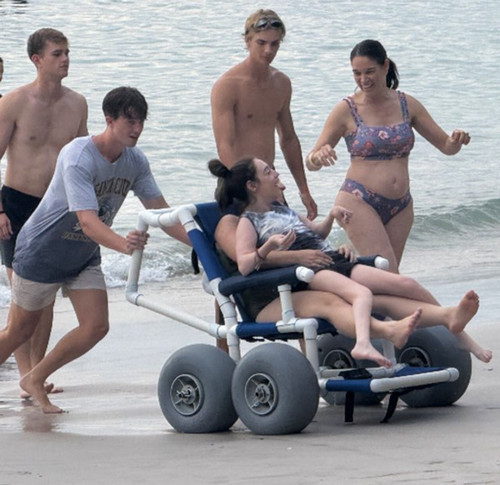Students engineer an accessible path to the ocean
News
SUMMARY: A team of JMU ISAT and Engineering students partnered with the Punta Leona Beach Club and Nature Resort in Costa Rica to design a beach wheelchair that helps individuals with mobility limitations navigate the sand and surf.
For most, a beach trip means sunshine, sand, and floating in the waves. For people with physical disabilities, though, that experience can feel out of reach.
As part of the CISE Energy and Environment International Summer Program in Costa Rica, a team of Engineering and Integrated Science and Technology students, Ethan Johnson, Charles McClernon (ISAT), Jace Arcone, Daniel Turner, and George Zacharias (Engineering), spent the spring semester designing an accessible beach wheelchair for the Punta Leona Beach Club and Nature Resort in Costa Rica.
“We already had a beach wheelchair, but it needed improvements,” said Jose Calderon, the resort manager and a longtime partner of JMU's Center for Global Engagement.
“We wanted a chair that could be easily maintained and reproduced locally — a scalable solution tailored to the Costa Rican environment,” said Karim Altaii, engineering professor and project advisor.
Collaborating closely rather than dividing into rigid roles, the team sketched ideas, modeled parts in SolidWorks, debated materials, and combined the best features from each design iteration.
After presenting their initial designs to Calderon, he brought in Natalia Vindas, an adaptive surfer, accessibility consultant, and president of Costa Rica’s Adaptive Surfing Association. A civil engineer herself, Vindas experienced firsthand how difficult it can be to access the beach after a spinal cord injury in 2008.
“My brothers had to carry me everywhere because there were no beach wheelchairs at the time,” Vindas said. “Later, adaptive surfing opened that door again for me and gave me back the ocean. It’s empowering. It’s freedom. That’s what these wheelchairs can offer, too.”
|
“They’re stepping out of their comfort zones and gaining international experience. They’re learning how to communicate across cultures, how to adapt designs for different environments, and how to serve a global community.” — Karim Altaii |
Vindas pointed out details that the team didn’t anticipate. Footrests that accommodate spasms, detachable belts for users with limited core strength, and padded armrests to improve comfort without adding flotation that could destabilize the chair in the surf. She also advised on material selection: minimizing maintenance in a salty, sandy, tropical environment, ensuring parts were easy to clean, and suggesting designs that might turn more easily on uneven sand.
“We hadn’t thought about some of these details until Natalia walked us through them,” said Johnson. “Her feedback showed us why user input matters at every stage.”
After months of design and iteration, the team finalized their first prototype. The four-wheel chair featured a lightweight PVC frame, oversized beach wheels for soft sand and shallow water, stainless steel fasteners to resist corrosion, and a breathable mesh seat that dried quickly and shed sand. They also incorporated Vindas’ suggestions: padded, removable armrests for easy side transfers and a detachable belt that added safety without sacrificing comfort or agility.
“It had to be comfortable, safe, and simple enough to reproduce on-site,” said Zacharias. “We wanted the resort staff to be able to source parts locally if needed and build additional chairs themselves.”
In July, after months of planning, prototyping, and collaborating on campus, they traveled to Costa Rica to test their final design.
“We got to the beach early and tested the chair ourselves first,” said Johnson. “It floated more than expected, but it handled well in the waves.
When Vindas arrived, the team carefully transferred her into the chair and guided her into the ocean. Together, they floated in the surf, supporting Vindas and observing the chair’s performance. The buoyancy worked in their favor, though the chair leaned back a bit too far.

As the team gathered feedback from Vindas, a woman approached with her teenage daughter, Nikki, who had never been in the ocean because of her cerebral palsy. The team invited the duo to try the chair.
“We were nervous at first,” said McClernon. “But when Nikki got in, with her mom’s support, it was beautiful. She had an ear-to-ear smile, laughing as the waves came up behind her.” Altaii agreed. “Nikki’s smile and the smile on her mother’s face made all this worthwhile.”
“This is the first time we’ve seen our work truly make a difference,” said Arcone. “In class, we design for a grade. Here, we’re designing to bring joy and access to someone’s life.”
“Seeing how much fun she had reminded us why we’re doing this," said Turner. "This wasn’t just a prototype anymore — it was real.”
Feedback from Vindas and the encounter with Nikki highlighted the need for a second prototype — to serve a broader range of mobility needs. Using locally sourced materials, the team built a lighter, three-wheel version that was easier to maneuver in the sand, refined its structure for stability in the surf, and kept the design simple enough for resort staff to replicate.
“They’re stepping out of their comfort zones and gaining international experience,” Altaii said. “They’re learning how to communicate across cultures, how to adapt designs for different environments, and how to serve a global community.”
“This project showed us what engineering can be when you take it outside the classroom,” said Turner. “It’s not just about solving problems — it’s about people.”
